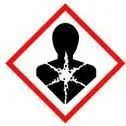
Chemical risk prevention is regulated by the French Labor Code (articles R.4412-59 to R.4412-93), which uses the term CMR: Carcinogenic, Mutagenic, Reprotoxic. In this article, we explore the definition of a CMR, the main regulations that apply, and CMR classifications.
CMR definition
A CMR is a chemical substance that has the capacity to cause harmful effects on human health or the environment. The term "CMR" is an acronym for three categories of adverse effects:
- Carcinogenic : Chemical product (e.g. asbestos, wood dust, benzene, etc.) or process capable of causing cancer in people exposed to it, whether by inhalation, ingestion or skin contact.
- Mutagenic : A chemical that causes genetic mutations in living cells, leading to permanent DNA alterations and hereditary changes.
- Reprotoxic : Chemical (e.g. lead) that has harmful effects on reproduction in both men and women, leading to fertility problems, birth defects or complications during pregnancy.
The European Commission recently added 24 new CMR substances (Carcinogenic, Mutagenic or Reprotoxic) of category 1A or 1B to the list of REACH restrictions - Annex XVII. These include ammonium bromide, theophylline, 2-ethylhexanoic acid and its salts, and 2,4,6-tri-tert-butylphenol.
The inclusion of these substances on the REACH restrictions list will lead to a ban on their marketing and use from December 1, 2023.
Regulations applying to CMRs
Due to their hazardous nature, CMR substances are subject to strict regulations to ensure appropriate protection of workers, consumers and the environment. Regulations vary from country to country, but here are a few examples of international and European regulations associated with CMRs:
- Classification, Labeling and Packaging (CLP) : European regulation 1272/2008, known as CLP, defines the criteria for the classification, labeling and packaging of hazardous chemicals, including CMRs. Products containing CMRs must be properly labeled to warn users of the associated risks.
- REACH Regulation : European regulation no. 1907/2006 on the Registration, Evaluation, Authorization and Restriction of Chemicals (REACH) imposes obligations on manufacturers and importers of chemical substances, including CMRs. Some CMRs may require special authorization to be used on the European market.
- Rotterdam Convention : This international convention regulates trade in hazardous chemicals, including certain CMRs, ensuring that importing countries are informed of the risks associated with the chemicals they receive.
- Stockholm Convention : This international convention aims to protect human health and the environment from persistent organic pollutants (POPs), including certain CMRs, by controlling their production, use and disposal.
These regulations aim to limit exposure of individuals to CMR substances, prevent health risks and minimize negative impacts on the environment.
Classification CMR
The effects of CMR substances are classified into 3 categories:
- CMR 1A with proven effects
- CMR 1B whose effects are assumed or presumed
- CMR category 2 for which effects are suspected
Substances which have been subject to harmonized CMR classification at European level are listed in Annex VI of the CLP Regulation. This annex also contains classifications harmonized at European level. It is regularly updated to take account of advances in scientific knowledge.
Under CLP criteria, the GHS08 pictogram "Health hazard" must be used irrespective of the category.

- The "Danger" warning is used for categories 1A and 1B, while the "Caution" warning is used for category 2.
- Hazard statement H350, "May cause cancer", applies to categories 1A and 1B, while hazard statement H351, "Suspected of causing cancer", applies to category 2.
In all cases, the route of exposure must be mentioned in addition to the hazard, but only if it has been rigorously proven that no other route of exposure causes the same hazard.
Where are CMRs located?
According to the 2005 INRS inventory, the annual consumption of CMR chemical agents amounts to 324, as well as several hundred petroleum derivatives. At that time, the total quantity of CMR chemical agents used in France reached 4.8 million tonnes.
According to INRS, the main sectors concerned by CMR products are :
- building and civil engineering sector
- rail and shipbuilding
- metallurgy, glass and metals
- chemical and pharmaceutical industries
- leather and rubber industry
- oil industry
- wood industry
- agriculture
- research laboratories
- services (maintenance, cleaning, etc.)
Some examples of CMR products:
- Formaldehyde
- 1,2-dichloroethane
- Sodium and potassium chromates and dichromates
- Triglyccidyl isocyanurate
- Dihexyl phthalate
- Lead compounds
Want to find out more about CMR substances?
Contact our experts free of charge and without obligation!
Chemical Newsletter: Subscribe and receive monthly information and updates on regulations
Need a newsletter to help you keep abreast of regulations and anticipate your short-, medium- and long-term obligations? Chemical Insight is the solution that helps you stay compliant while preventing the obsolescence of your chemical substances. Sign up now!
Chemical risk prevention is regulated by the French Labor Code (articles R.4412-59 to R.4412-93), which uses the term CMR: Carcinogenic, Mutagenic, Reprotoxic. In this article, we explore the definition of a CMR, the main regulations that apply, and CMR classifications.
CMR definition
A CMR is a chemical substance that has the capacity to cause harmful effects on human health or the environment. The term "CMR" is an acronym for three categories of adverse effects:
- Carcinogenic : Chemical product (e.g. asbestos, wood dust, benzene, etc.) or process capable of causing cancer in people exposed to it, whether by inhalation, ingestion or skin contact.
- Mutagenic : A chemical that causes genetic mutations in living cells, leading to permanent DNA alterations and hereditary changes.
- Reprotoxic : Chemical (e.g. lead) that has harmful effects on reproduction in both men and women, leading to fertility problems, birth defects or complications during pregnancy.
The European Commission recently added 24 new CMR substances (Carcinogenic, Mutagenic or Reprotoxic) of category 1A or 1B to the list of REACH restrictions - Annex XVII. These include ammonium bromide, theophylline, 2-ethylhexanoic acid and its salts, and 2,4,6-tri-tert-butylphenol.
The inclusion of these substances on the REACH restrictions list will lead to a ban on their marketing and use from December 1, 2023.
Regulations applying to CMRs
Due to their hazardous nature, CMR substances are subject to strict regulations to ensure appropriate protection of workers, consumers and the environment. Regulations vary from country to country, but here are a few examples of international and European regulations associated with CMRs:
- Classification, Labeling and Packaging (CLP) : European regulation 1272/2008, known as CLP, defines the criteria for the classification, labeling and packaging of hazardous chemicals, including CMRs. Products containing CMRs must be properly labeled to warn users of the associated risks.
- REACH Regulation : European regulation no. 1907/2006 on the Registration, Evaluation, Authorization and Restriction of Chemicals (REACH) imposes obligations on manufacturers and importers of chemical substances, including CMRs. Some CMRs may require special authorization to be used on the European market.
- Rotterdam Convention : This international convention regulates trade in hazardous chemicals, including certain CMRs, ensuring that importing countries are informed of the risks associated with the chemicals they receive.
- Stockholm Convention : This international convention aims to protect human health and the environment from persistent organic pollutants (POPs), including certain CMRs, by controlling their production, use and disposal.
These regulations aim to limit exposure of individuals to CMR substances, prevent health risks and minimize negative impacts on the environment.
Classification CMR
The effects of CMR substances are classified into 3 categories:
- CMR 1A with proven effects
- CMR 1B whose effects are assumed or presumed
- CMR category 2 for which effects are suspected
Substances which have been subject to harmonized CMR classification at European level are listed in Annex VI of the CLP Regulation. This annex also contains classifications harmonized at European level. It is regularly updated to take account of advances in scientific knowledge.
Under CLP criteria, the GHS08 pictogram "Health hazard" must be used irrespective of the category.

- The "Danger" warning is used for categories 1A and 1B, while the "Caution" warning is used for category 2.
- Hazard statement H350, "May cause cancer", applies to categories 1A and 1B, while hazard statement H351, "Suspected of causing cancer", applies to category 2.
In all cases, the route of exposure must be mentioned in addition to the hazard, but only if it has been rigorously proven that no other route of exposure causes the same hazard.
Where are CMRs located?
According to the 2005 INRS inventory, the annual consumption of CMR chemical agents amounts to 324, as well as several hundred petroleum derivatives. At that time, the total quantity of CMR chemical agents used in France reached 4.8 million tonnes.
According to INRS, the main sectors concerned by CMR products are :
- building and civil engineering sector
- rail and shipbuilding
- metallurgy, glass and metals
- chemical and pharmaceutical industries
- leather and rubber industry
- oil industry
- wood industry
- agriculture
- research laboratories
- services (maintenance, cleaning, etc.)
Some examples of CMR products:
- Formaldehyde
- 1,2-dichloroethane
- Sodium and potassium chromates and dichromates
- Triglyccidyl isocyanurate
- Dihexyl phthalate
- Lead compounds
Want to find out more about CMR substances?
Contact our experts free of charge and without obligation!
Chemical Newsletter: Subscribe and receive monthly information and updates on regulations
Need a newsletter to help you keep abreast of regulations and anticipate your short-, medium- and long-term obligations? Chemical Insight is the solution that helps you stay compliant while preventing the obsolescence of your chemical substances. Sign up now!







